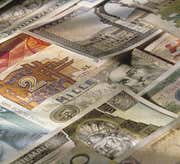|

|
So far we've learned that under the right circumstances, the P/E ratio can help us determine whether a company is over- or under-valued, informing us as to which stocks to buy and which to sell or avoid. But P/E analysis is only valid in certain circumstances and it has some important pitfalls that investors should understand. Some factors that can undermine the usefulness of the P/E ratio include the following.
Accounting Method
The earnings reported by a company is an accounting figure that includes non-cash items such as depreciation and amortization. Furthermore, the guidelines for determining earnings are governed by accounting rules called the Generally Accepted Accounting Principles (GAAP) that change over time and are different in each country. Moreover, some companies use GAAP accounting standards, while others use a different set of standards known as the International Financial Reporting Standards (IFRS). EPS can therefore be twisted into various numbers depending on how a company keeps their books. Corporate managers that are incentivized to lower reported earnings for tax reasons, for example, may erroneously give the market the perception of being undervalued when it’s not. The result is that we often don't know whether we are comparing the same figures unless we do a bit of due diligence to confirm the accounting practices of the companies being compared. (For more on this, see The 5 Types Of EPS.)
Companies can also game their P/E ratio by acquiring a company that has a significantly lower P/E than its own, thus lowering the P/E of the combined company. This disliked technique, known as bootstrapping the P/E can lead to a company’s shares rising without any material earnings growth.
Inflation
In times of high inflation, inventory and depreciation costs tend to be understated on a company’s balance sheet because the replacement costs of goods and equipment rise with the general level of prices. Thus, P/E ratios tend to be lower during times of high inflation because the market sees earnings as artificially distorted upwards. As with all ratios, it's more valuable to look at the consistency of a P/E over time in order to determine the trend. Inflation makes this task more difficult, as past information is less useful today if inflation expectations are greater than they were in the past. (See also: Reading the Balance Sheet.)
Many Interpretations
A low P/E ratio does not necessarily mean that a company is undervalued. Rather, it could mean that the market believes the company is headed for financial trouble in the near future. Stocks that go down in price and stay down usually do so for a reason. It may be that a company has warned that earnings will come in lower than expected. This wouldn't be reflected in a trailing P/E ratio until earnings are actually released, during which time the company might look undervalued. Similarly, a company with very low earnings now may command a very high P/E ratio even though it isn’t necessarily overvalued. The company may have just IPO’d and growth expectations are very high, or expectations remain high since the company dominates the technology in its space.
For example, Amazon.com (AMZN) still has a P/E of around 170 even though it is no longer a “new” company – but investors still believe that it is not overvalued. Companies that have no earnings, or which lose money every year, have P/E’s that are not easily interpretable. When Amazon was a new company, it had many consecutive years of negative earnings, but a negative P/E is not the same as a very low P/E! Often investors pay little regard to the value of the P/E ratio when a company has negative earnings.
P/E Ratio: It's Not A Crystal Ball
-
 Investing
InvestingHow To Use The P/E Ratio And PEG To Tell A Stock's Future
The P/E ratio is used to calculate stock price valuation. However the PEG ratio includes earnings growth and can provide insight as to whether the P/E valuation is justified. -
 Investing
InvestingCan Investors Trust The P/E Ratio?
The P/E ratio is one of the most popular stock market ratios, but it has some serious flaws that investors should know about. -
 Investing
InvestingBeware False Signals From the P/E Ratio
The P/E ratio is a simple tool for evaluating a company, but it can also send false signals. -
 Investing
InvestingDifferences Between Forward P/E And Trailing P/E
The most common types of price to earnings ratios are forward P/E and trailing P/E. Find out how they differ and the advantages and drawbacks of each. -
 Investing
InvestingAre stocks with low P/E ratios always better?
Is a stock with a lower P/E ratio always a better investment than a stock with a higher one? The short answer is no. The long answer is it depends. -
 Trading
TradingValue-Priced Stocks to Watch in 2016 (AMBC, VIPS)
In terms of P/E and Forward P/E these stocks are trading at low valuations. Watch these technical price levels for buying opportunities in 2016. -
 Investing
InvestingUnderstanding The P/E Ratio
Learn what the price/earnings ratio really means and how you should use it to value companies.


